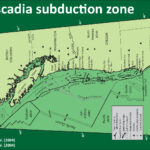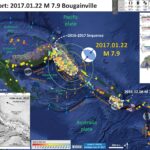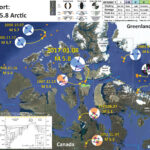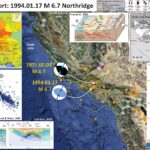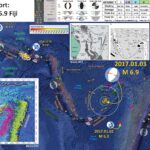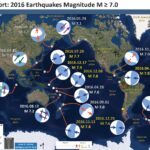Today (possibly tonight at about 9 PM) is the birthday of the last known Cascadia subduction zone (CSZ) earthquake. There is some evidence that there have been more recent CSZ earthquakes (e.g. late 19th century in southern OR / northern…
Earthquake Report: Bougainville! (western equatorial Pacific)
Last night (my time) we had a large earthquake along a plate boundary that is one of the most tectonically active regions in the world. There was an earthquake with a magntude of M 7.9 along the San Cristobal Trench…
Earthquake Report: Celebes Sea!
Catching up on some earthquake reports on a Friday night. This earthquake happened on 2017.01.10 in a region to the west of the Molluca Strait. I have reported on Molucca Strait earthquakes several times before as this is a very…
Earthquake Report: Arctic!
Well, I put this and my next earthquake report together shortly after these earthquakes happened, but I was otherwise busy before I could present them online. There was an earthquake in the Arctic on 2017.01.08, along the channel of one…
Earthquake Report: 1994 Northridge!
Today is the commemoration of the 1994 M 6.7 Northridge Earthquake. I was living in Arcata at the time (actually in my school bus in a driveway to save money). I remember calling my mom from a pay phone to…
Earthquake Report: Explorer plate!
In the past 2 days there have been a few earthquakes in the Explorer plate region along the Pacific-North America plate boundary. On March 19 of this year there was a series of earthquakes in this same region (to the…
Earthquake Report: North Fiji Basin!
We just had a large earthquake along the West Fiji Ridge, one of the spreading ridges that forms the North Fiji Basin. Here is the USGS website for this M 7.2 earthquake. This earthquake was relatively shallow and, probably since…
Earthquake Report: 2016 Summary Cascadia
Here I summarize the seismicity for Cascadia in 2016. I limit this summary to earthquakes with magnitude greater than or equal to M 4.0. I reported on all but five of these earthquakes. I put this together a couple weeks…
Earthquake Report: 2016 Summary
Here I summarize the global seismicity for 2016. I limit this summary to earthquakes with magnitude greater than or equal to M 7.0. I reported on all but two of these earthquakes. There were no earthquakes as large as an…

